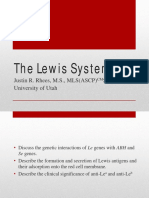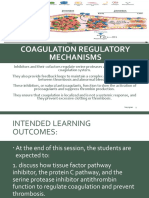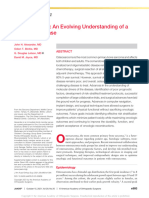Lab Policies Alkaline Phosphatase C311 Lab 8803
Lab Policies Alkaline Phosphatase C311 Lab 8803
Uploaded by
Valdez Francis ZaccheauCopyright:
Available Formats
Lab Policies Alkaline Phosphatase C311 Lab 8803
Lab Policies Alkaline Phosphatase C311 Lab 8803
Uploaded by
Valdez Francis ZaccheauOriginal Title
Copyright
Available Formats
Share this document
Did you find this document useful?
Is this content inappropriate?
Copyright:
Available Formats
Lab Policies Alkaline Phosphatase C311 Lab 8803
Lab Policies Alkaline Phosphatase C311 Lab 8803
Uploaded by
Valdez Francis ZaccheauCopyright:
Available Formats
Standard Operating Procedure
Subject Alkaline Phosphatase C311
Index Number Lab-8803
Section Laboratory
Subsection Regional/Affiliates
Category Departmental
Contact Dayton, Judy L
Last Revised 9/17/2019
References
Required document for Laboratory Accreditation by the College of American Pathologists (CAP), Centers
for Medicare and Medicaid Services (CMS), and/or COLA.
Applicable To
Employees of the Gundersen Boscobel Area Hospitals and Clinics laboratories and Palmer Lutheran
Hospital and Clinics Laboratories.
Detail
PRINCIPLE:
The COBAS C311 provides a colorimetric assay in accordance with a standardized method.
In the presence of magnesium and zinc ions, p-nitrophenyl phosphate is cleaved by phosphatases into
phosphate and p-nitrophenol.
p-nitrophenyl phosphate + H2O → phosphate + p-nitrophenol
The p-nitrophenol released is directly proportional to the catalytic ALP activity. It is determined by
measuring the increase in absorbance.
CLINICAL SIGNIFICANCE:
Alkaline phosphatase in serum consists of four structural genotypes: the liver-bone-kidney type, the
intestinal type, the placental type and the variant from the germ cells. It occurs in osteoblasts,
hepatocytes, leukocytes, the kidneys, spleen, placenta, prostate and the small intestine. The liver-bone-
kidney type is particularly important.
A rise in the alkaline phosphatase occurs with all forms of cholestasis, particularly with obstructive
jaundice. It is also elevated in diseases of the skeletal system, such as Paget’s disease,
hyperparathyroidism, rickets and osteomalacia, as well as with fractures and malignant tumors. A
considerable rise in the alkaline phosphatase activity is sometimes seen in children and juveniles. It is
caused by increased osteoblast activity following accelerated bone growth.
SPECIMEN:
Universal precautions apply.
Serum and/or Li-heparin plasma
Specimen Stability:
7 days at 15-25 °C
Lab-8803 |Alkaline Phosphatase C311 Page 1 of 4
Standard Operating Procedure
7 days at 2-8 °C
2 months at (-15)-(-25) °C
REAGENTS/MATERIALS:
COBAS C311
R1 2-amino-2-methyl-1-propanol: 1.724 mol/L, pH 10.44 (30 °C); magnesium acetate: 3.83 mmol/L;
zinc sulfate: 0.766 mmol/L; N-(2-hydroxyethyl)-ethylenediamine triacetic acid: 3.83 mmol/L
R2 p-nitrophenyl phosphate: 132.8 mmol/L, pH 8.50 (25 °C); preservatives
R1 is in position B and R2 is in position C.
Reagent precautions:
R1 contains 2-Amino-2-methyl-1-propanol.
Irritant
Irritating to eyes and skin.
Avoid contact with skin and eyes.
Reagents Stability:
ALP2S, ALP2L
Shelf life at 2-8 °C: See expiration date on COBAS c pack label.
On-board in use and refrigerated on the analyzer: 8 weeks
Diluent NaCl 9 %
Shelf life at 2-8 °C: See expiration date on COBAS c pack label.
On-board in use and refrigerated on the analyzer: 12 weeks
EQUIPMENT/INSTRUMENTATION:
Calibration:
Calibrators S1: H2O
S2: C.f.a.s.
Calibration mode Linear
Calibration frequency 2-point calibration
1. At initial installation
2. after reagent lot change
3. If required after maintenance or repair
4. as required following quality control procedures
Calibration Preparation, storage and stability: Refer to the COBAS C311 User Manual located in the
laboratory.
QUALITY CONTROL:
Quality Control frequency
Two levels of Quality control should be performed at a minimum:
1. once every twenty-four (24) hours
Lab-8803 |Alkaline Phosphatase C311 Page 2 of 4
Standard Operating Procedure
2. if a new cassette of reagent is put in use
3. if a calibration is performed
Refer to Lab-4405 Quality Control Criteria for Chemistry for interpretation of QC.
Implementation
Refer to the C311 User’s Manual located in the laboratory.
PROCEDURE NOTES:
AMR (Analytic Measurement Range): 5-1200 U/L
Extended Range:
5-6000 U/L with automatic re-run (1:5 dilution)
Report values less than 5 as “<5 U/L”
Report values greater than 6000 as “>6000 U/L”
If the provider requires further dilution on a sample reporting >6000 U/L, use 0.9% NaCl as the diluent.
Diluted value must fall between 5-1200 U/L.
Determine samples having higher activities via the rerun function. Dilution of samples via the rerun
function is a 1:5 dilution. Results from samples diluted using the rerun function are automatically
multiplied by a factor of 5.
CALCULATIONS: N/A
INTERPRETATION:
Expected Values
Adults: Males 40-129 U/L
Females 35-104 U/L
MALES
1 - < 10 years 142-335 U/L (2.37-5.59 µkat/L)
10 - < 13 years 129-417 U/L (2.15-6.96 µkat/L)
13 - < 15 years 116-468 U/L (1.94-7.82 µkat/L)
15 - < 17 years 82-331 U/L (1.37-5.53 µkat/L)
17 - < 19 years 55- 149 U/L (0.92-2.49 µkat/L)
FEMALES
1 - < 10 years 142-335 U/L (2.37-5.59 µkat/L)
10 - < 13 years 129-417 U/L (2.15-6.96 µkat/L)
13 - < 15 years 57-254 U/L (0.95-4.24 µkat/L)
15 - < 17 years 50-117 U/L (0.84-1.95 µkat/L)
17 - < 19 years 45-87 U/L (0.75-1.45 µkat/L)
Lab-8803 |Alkaline Phosphatase C311 Page 3 of 4
Standard Operating Procedure
LIMITATIONS:
Criterion: Recovery within ± 10 % of initial value at an alkaline phosphatase activity of 100 U/L (1.67
µkat/L).
Icterus: No significant interference up to an I index of 60 for conjugated and unconjugated bilirubin
(approximate conjugated and unconjugated bilirubin concentration: 1026 µmol/L or 60 mg/dL).
Hemolysis: No significant interference up to an H index of 200 (approximate hemoglobin concentration:
124 µmol/L or 200 mg/dL).
Lipemia (Intralipid): No significant interference up to an L index of 2000. There is poor correlation
between the L index (corresponds to turbidity) and triglycerides concentration.
Drugs: No interference was found at therapeutic concentrations using common drug panels.
In very rare cases, gammopathy, in particular type IgM (Waldenström’s macroglobulinemia), may cause
unreliable results.
For diagnostic purposes, the results should always be assessed in conjunction with the patient’s medical
history, clinical examination and other findings.
Special Wash Programming: The use of special wash steps is mandatory when certain test combinations
are run together on Roche/Hitachi cobas c systems. The latest version of the carry-over evasion list can
be found with the NaOHD/SMS/Multiclean/SCCS or the NaOHD/SMS/SmpCln1+2/SCCS Method Sheets.
For further instructions refer to the operator's manual. Where required, special wash/carry-over evasion
programming must be implemented prior to reporting results with this test.
REVIEW AND CHANGES:
This document and all attached forms should be reviewed optimally on an annual basis, with two years
as the maximum review date. Review will be done by the Technical Leader, Supervisor, Manager,
Medical Director or other designated person. Changes require retyping the document, and review by
the Medical Director.
REFERENCES:
1. COBAS C311 Alkaline Phosphatase IFCCmethod Sheet, Roche Doagnostics, Indianapolis, IN
2. Moss, DW; Alkaline Phosphatase isoenzymes; Clin Chem 1982; 28: 2007-2016
3. Hausamen TU, Helger R, Rick W, et al. Optimal conditions for the determination of serum alkaline
phosphatase by a new kinetic method. Clin Chim Acta 1967;15:241-245.
4. Tietz NW, Rinker AD, Shaw LM. J Clin Chem Clin Biochem 1983;21:731-748.
5. COBAS C311 User’s Manual.
6. COBAS C311 Method Sheet.
Lab-8803 |Alkaline Phosphatase C311 Page 4 of 4
You might also like
- A93a01225cen Glucose Pap CPDocument6 pagesA93a01225cen Glucose Pap CPimrecoNo ratings yet
- Lab Policies C Reactive Protein CRP - Cobas c501 Lab 4232Document4 pagesLab Policies C Reactive Protein CRP - Cobas c501 Lab 4232Wisnu Dwi PutraNo ratings yet
- Lab Policies Hemoglobin A1C - Cobas c501 Lab 4004Document6 pagesLab Policies Hemoglobin A1C - Cobas c501 Lab 4004yosefin100% (1)
- Placental ExaminationDocument13 pagesPlacental ExaminationAnuradha Maurya75% (4)
- 8 AmylaseDocument9 pages8 AmylaseAzhar Clinical Laboratory TubeNo ratings yet
- 5-Alkaline PhosphataseDocument7 pages5-Alkaline PhosphataseAzhar Clinical Laboratory TubeNo ratings yet
- Lab Policies Triglycerides - Cobas c501 Lab 4455Document4 pagesLab Policies Triglycerides - Cobas c501 Lab 4455Marj MendezNo ratings yet
- 14 CreatinineDocument8 pages14 CreatinineAzhar Clinical Laboratory TubeNo ratings yet
- 4 AlbuminDocument6 pages4 AlbuminAzhar Clinical Laboratory TubeNo ratings yet
- Glucose KitDocument2 pagesGlucose KitJuan Enrique Ramón OrellanaNo ratings yet
- Quantitative Determination of Alkaline Phosphatase (ALP) IVDDocument1 pageQuantitative Determination of Alkaline Phosphatase (ALP) IVDPhong Nguyễn WindyNo ratings yet
- 10 AlciumDocument9 pages10 AlciumAzhar Clinical Laboratory TubeNo ratings yet
- Clinical ChemistryDocument38 pagesClinical Chemistryxox18No ratings yet
- CALCIUM CPC+STD ANG 2015 02 17Document2 pagesCALCIUM CPC+STD ANG 2015 02 17yehiwal756No ratings yet
- 174 - 13 UREA PDF - 28-Euro Procedure SheetDocument2 pages174 - 13 UREA PDF - 28-Euro Procedure SheetP VijayaNo ratings yet
- Alpha-AMYLASE BLOSR6x82 ENDocument4 pagesAlpha-AMYLASE BLOSR6x82 ENMeethuanNo ratings yet
- Creatinina - 2015 1001111 PDFDocument2 pagesCreatinina - 2015 1001111 PDFIng BiomédicoNo ratings yet
- ALTL enDocument3 pagesALTL enyolanda0811No ratings yet
- ALBUMIN BLOSR6x02 ENDocument2 pagesALBUMIN BLOSR6x02 ENMeethuanNo ratings yet
- Bsis13-I Creatinina 2014Document1 pageBsis13-I Creatinina 2014Alejandra MoralesNo ratings yet
- BIOPRO J MET Uric Acid 508Document15 pagesBIOPRO J MET Uric Acid 508musembijosef2011No ratings yet
- Bilirubin Total Blosr6x12 enDocument2 pagesBilirubin Total Blosr6x12 enMeethuanNo ratings yet
- CT10192 Rev. en 03 Rev. 02 2Document4 pagesCT10192 Rev. en 03 Rev. 02 2KOUAME EDYMAIN FRANCISNo ratings yet
- SGPT Serum Glutamic Pyruvic TransaminaseDocument2 pagesSGPT Serum Glutamic Pyruvic TransaminaseNaveed WarraichNo ratings yet
- Sop of Alkaline PhosphataseDocument6 pagesSop of Alkaline PhosphataseUMMID WashimNo ratings yet
- KR10150 Rev02Document2 pagesKR10150 Rev02KOUAME EDYMAIN FRANCISNo ratings yet
- Clonatest Amylase MRDocument4 pagesClonatest Amylase MRSuprovet LabotatorioNo ratings yet
- UA2 enDocument4 pagesUA2 enhilmayuniarNo ratings yet
- CT10282Document4 pagesCT10282KOUAME EDYMAIN FRANCISNo ratings yet
- KR10060Document2 pagesKR10060KOUAME EDYMAIN FRANCISNo ratings yet
- Lyphase 11760I-Reagent A 510 Reagent B 300 Sample 9 Standard 113Document1 pageLyphase 11760I-Reagent A 510 Reagent B 300 Sample 9 Standard 113mahinNo ratings yet
- En - Alkaline PhosphataseDocument4 pagesEn - Alkaline PhosphatasecarineNo ratings yet
- PotasiumDocument2 pagesPotasiumlabextreme29No ratings yet
- Clonatest Cholesterol MRDocument4 pagesClonatest Cholesterol MRSuprovet LabotatorioNo ratings yet
- Ifu 1418 1092 LactateDocument1 pageIfu 1418 1092 LactateLê Văn DươngNo ratings yet
- Autopure T LDL-C: Specimen Collection & PreservationDocument2 pagesAutopure T LDL-C: Specimen Collection & PreservationNanda Nabilah UbayNo ratings yet
- Glucose c111 RocheDocument3 pagesGlucose c111 RocheHarditya FirdhausNo ratings yet
- Cholesterol KitDocument2 pagesCholesterol KitRahma Ayu WulandariNo ratings yet
- Alkaline Phosphatase FS : Order Information SpecimenDocument3 pagesAlkaline Phosphatase FS : Order Information SpecimenmnemonicsNo ratings yet
- Biopro J Met Phosphorus 508Document15 pagesBiopro J Met Phosphorus 508Elizabeth FridayNo ratings yet
- CholinesteraseDocument2 pagesCholinesteraseGeorge-Alexandru MarinescuNo ratings yet
- Pi e AP Ifcc 2Document2 pagesPi e AP Ifcc 2muhammadsufyanfp12No ratings yet
- 12521IDocument1 page12521IVe SeptianaNo ratings yet
- Phosphorus MDDocument1 pagePhosphorus MDPhong Nguyễn WindyNo ratings yet
- Ftna-Assl4 1Document2 pagesFtna-Assl4 1Matthew KingNo ratings yet
- 1115000I Rev. 03 - 2Document2 pages1115000I Rev. 03 - 2kirubel demelashNo ratings yet
- Summary Report August 2012 Edited - V2 - 2Document26 pagesSummary Report August 2012 Edited - V2 - 2CARLOSNo ratings yet
- Mdbsis45 Uric Liq 03-2012Document2 pagesMdbsis45 Uric Liq 03-2012juanNo ratings yet
- 1.alpha AmylaseDocument2 pages1.alpha AmylaseHiếu Chí PhanNo ratings yet
- 9 AstDocument7 pages9 AstAzhar Clinical Laboratory TubeNo ratings yet
- Determination of Sugars, Byproducts, and Degradation Products in Liquid Fraction Process SamplesDocument14 pagesDetermination of Sugars, Byproducts, and Degradation Products in Liquid Fraction Process SamplesfhrzsptrNo ratings yet
- Biomed LDHDocument2 pagesBiomed LDHStaci WashingtonNo ratings yet
- En CK (Nac) Baosr6x79 UsDocument3 pagesEn CK (Nac) Baosr6x79 UscarineNo ratings yet
- AM (179) Glu PDFDocument4 pagesAM (179) Glu PDFIftikhar AliNo ratings yet
- 1105000I Rev. 02Document2 pages1105000I Rev. 02Riadh BenyoucefNo ratings yet
- APOAT enDocument3 pagesAPOAT enYunita RapaNo ratings yet
- Clonatest Alt/Gpt OptDocument4 pagesClonatest Alt/Gpt OptSuprovet LabotatorioNo ratings yet
- 12 CKLDocument7 pages12 CKLAzhar Clinical Laboratory TubeNo ratings yet
- Measurement of Antioxidant Activity and Capacity: Recent Trends and ApplicationsFrom EverandMeasurement of Antioxidant Activity and Capacity: Recent Trends and ApplicationsResat ApakNo ratings yet
- MTPC 140: Molecular Biology and DiagnosticsDocument37 pagesMTPC 140: Molecular Biology and DiagnosticsValdez Francis ZaccheauNo ratings yet
- MTPC 140: Molecular Biology and DiagnosticsDocument17 pagesMTPC 140: Molecular Biology and DiagnosticsValdez Francis ZaccheauNo ratings yet
- MTPC 140: Molecular Biology and DiagnosticsDocument26 pagesMTPC 140: Molecular Biology and DiagnosticsValdez Francis ZaccheauNo ratings yet
- MTPC 140: Molecular Biology and DiagnosticsDocument40 pagesMTPC 140: Molecular Biology and DiagnosticsValdez Francis ZaccheauNo ratings yet
- MTPC 120: Molecular Biology and DiagnosticsDocument16 pagesMTPC 120: Molecular Biology and DiagnosticsValdez Francis ZaccheauNo ratings yet
- How Is Rhesus (RH) Typing Performed? (2019, November 10) - Retrieved March 09, 2021, From 4. HDFN More On Harmening RH FactorDocument3 pagesHow Is Rhesus (RH) Typing Performed? (2019, November 10) - Retrieved March 09, 2021, From 4. HDFN More On Harmening RH FactorValdez Francis ZaccheauNo ratings yet
- Activity 1 Immunohema 1Document8 pagesActivity 1 Immunohema 1Valdez Francis ZaccheauNo ratings yet
- The Lewis System ARUPDocument60 pagesThe Lewis System ARUPValdez Francis ZaccheauNo ratings yet
- Act 4B IMMUNOHEMADocument3 pagesAct 4B IMMUNOHEMAValdez Francis ZaccheauNo ratings yet
- Meny, G. (N.D.) - Recognizing and Resolving ABO DiscrepanciesDocument3 pagesMeny, G. (N.D.) - Recognizing and Resolving ABO DiscrepanciesValdez Francis ZaccheauNo ratings yet
- CC 2 Activity 2Document5 pagesCC 2 Activity 2Valdez Francis ZaccheauNo ratings yet
- CC 2 Activity 4Document3 pagesCC 2 Activity 4Valdez Francis ZaccheauNo ratings yet
- Lactate Dehydrogenas E: Clinical Chemistry Post-Laboratory DiscussionDocument21 pagesLactate Dehydrogenas E: Clinical Chemistry Post-Laboratory DiscussionValdez Francis ZaccheauNo ratings yet
- Coagulation Regulatory Mechanisms: HeyzgranDocument34 pagesCoagulation Regulatory Mechanisms: HeyzgranValdez Francis ZaccheauNo ratings yet
- Enzymology: Cardiac Markers Pancreatic Markers Prostate MarkersDocument48 pagesEnzymology: Cardiac Markers Pancreatic Markers Prostate MarkersValdez Francis ZaccheauNo ratings yet
- Alkaline Phosphatase: Test Principle: Enzymatic ColorimetricDocument2 pagesAlkaline Phosphatase: Test Principle: Enzymatic ColorimetricValdez Francis ZaccheauNo ratings yet
- RH Blood Group SummaryDocument1 pageRH Blood Group SummaryValdez Francis ZaccheauNo ratings yet
- Laboratory+Practice+in+Molecular+Biology+and+Diagnostics 2Document3 pagesLaboratory+Practice+in+Molecular+Biology+and+Diagnostics 2Valdez Francis ZaccheauNo ratings yet
- Activity 6: LipaseDocument26 pagesActivity 6: LipaseValdez Francis ZaccheauNo ratings yet
- Immunoglobulins - Structure and Function Definition: Immunoglobulins (Ig)Document9 pagesImmunoglobulins - Structure and Function Definition: Immunoglobulins (Ig)Valdez Francis ZaccheauNo ratings yet
- 5235 EnglishDocument4 pages5235 EnglishValdez Francis ZaccheauNo ratings yet
- Iii.-Some Presuppositions of Moral Judgments: by Neil Coopeb DttbingDocument13 pagesIii.-Some Presuppositions of Moral Judgments: by Neil Coopeb DttbingValdez Francis ZaccheauNo ratings yet
- CAD - Dr. Assem BALAWI - Medics Index Member 4thjan 2011Document26 pagesCAD - Dr. Assem BALAWI - Medics Index Member 4thjan 2011jordanmedicsNo ratings yet
- Myasthenia GravisDocument10 pagesMyasthenia GravisLuis LazaroNo ratings yet
- Neuroinflammatory Diseases: DR Okanga NDocument50 pagesNeuroinflammatory Diseases: DR Okanga NGladys MainaNo ratings yet
- Diabetes Metabolism Res - 2023 - Lepesis - Systematic Review and Meta Analysis of The Effects of Foot and Ankle PhysicalDocument14 pagesDiabetes Metabolism Res - 2023 - Lepesis - Systematic Review and Meta Analysis of The Effects of Foot and Ankle Physicalnindi jemmyNo ratings yet
- 2a Nat PDFDocument12 pages2a Nat PDFACOB, Jamil C.No ratings yet
- Nursing Student's Lifestyle in The Areas of Behavioral WheelDocument23 pagesNursing Student's Lifestyle in The Areas of Behavioral WheelGlobal Research and Development Services100% (1)
- Learning Task 4Document3 pagesLearning Task 4Rz BorreroNo ratings yet
- Hubungan Antara Kadar Asam Urat Dengan Indeks Massa Tubuh... (Ulfa F, Zuraida Z, Enggar W)Document10 pagesHubungan Antara Kadar Asam Urat Dengan Indeks Massa Tubuh... (Ulfa F, Zuraida Z, Enggar W)Enggar WijayantiNo ratings yet
- Elevators: Oral SurgeryDocument8 pagesElevators: Oral SurgeryOmar FawazNo ratings yet
- Colibacillosis Prevalence in Broiler Chicken Infected by Escherichia Coli With Administration of Bio Additive, Probiotic, and AntibioticDocument13 pagesColibacillosis Prevalence in Broiler Chicken Infected by Escherichia Coli With Administration of Bio Additive, Probiotic, and AntibioticCatur DewantoroNo ratings yet
- What Is A Pacemaker?Document4 pagesWhat Is A Pacemaker?Abhishek MishraNo ratings yet
- 2023 Torts Exam For 2024 StudentsDocument3 pages2023 Torts Exam For 2024 StudentsclementinahuiNo ratings yet
- Osteosarcoma An Evolving Understanding of A.3Document12 pagesOsteosarcoma An Evolving Understanding of A.3cooperorthopaedicsNo ratings yet
- Chemical Pathology Reader UCT 2023 Formated 19 Jan 23Document481 pagesChemical Pathology Reader UCT 2023 Formated 19 Jan 23tmudzudzu11No ratings yet
- Atlantic Ultraviolet Sanitron BrochureDocument12 pagesAtlantic Ultraviolet Sanitron BrochureGlacialNo ratings yet
- Câu bị độngDocument6 pagesCâu bị độngphamtiendat310705No ratings yet
- Gaviscon Drug StudyDocument2 pagesGaviscon Drug StudyJOANNA MAE ABIA SALOMONNo ratings yet
- Hipertensi Dalam KehamilanDocument23 pagesHipertensi Dalam KehamilanbennyrolandnababanNo ratings yet
- SIR Model of EpidemicsDocument9 pagesSIR Model of EpidemicsMhamed HammoudiNo ratings yet
- AEFI Training - Presentation Final.1Document56 pagesAEFI Training - Presentation Final.1Minhajul IslamNo ratings yet
- Case StudyDocument15 pagesCase StudyHimaniNo ratings yet
- Running As A Key Lifestyle Medicine For LongevityDocument11 pagesRunning As A Key Lifestyle Medicine For LongevityKhang T. NguyenNo ratings yet
- Bssw-1-1-Group-6 ReportDocument23 pagesBssw-1-1-Group-6 ReportDavidAlingasaNo ratings yet
- Mechanical Ventilation - Chapter 2Document2 pagesMechanical Ventilation - Chapter 2Raninda JuliantiNo ratings yet
- Ekitela David Project ProposalDocument25 pagesEkitela David Project ProposalDavid EkitelaNo ratings yet
- 05 DR Nirmal Fredrik - NABH Requirements For HealthcareDocument72 pages05 DR Nirmal Fredrik - NABH Requirements For HealthcareVignesh BalajiNo ratings yet
- Diary of A SurvivorDocument6 pagesDiary of A SurvivorTheophilus AdeyemoNo ratings yet
- Enf Tiroidea y Embarazo Lancet 2018Document12 pagesEnf Tiroidea y Embarazo Lancet 2018Jair Alexander Quintero PanucoNo ratings yet
- What Are Blood Oxygen Levels Chart, Normal, Low & HighDocument1 pageWhat Are Blood Oxygen Levels Chart, Normal, Low & Highyaza.khanNo ratings yet















































































































